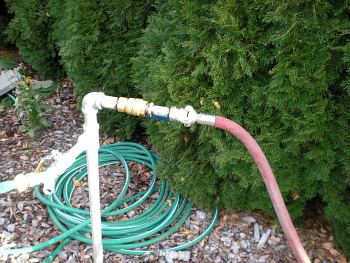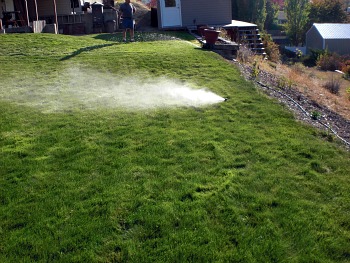What we cover
ToggleDo It Yourself Irrigation Tips: Preparing a Home System for Winter Using the 'Blow Out' Method
There are two ways to winterize a sprinkler system – manually drain the system or blow it out using an air compressor.
In warm climates it is usually sufficient to just shut off the water supply and drain the water from the pipes. However, manually draining the system often leaves water that collects in the low spots and if it freezes it will expand, bursting the pipes. So, in cold climates it is important to remove as much water as you can. This is best accomplished by blowing out the system with compressed air.
Winterizing sprinkler systems using the blow-out method is a job most handy DIYers can handle. However, forcing pressurized air through a sprinkler system can cause damage to components and is hazardous if not done properly. if you are unsure about any of the steps I highly recommend hiring a professional irrigation contractor to do the job for you.
What You Need:
- Safety Glasses – wear them!
- Air Compressor – capable of pushing a large volume of air through the pipes at low-pressure
- Valve Key to shut off in-ground valves
- Fittings to hook up the air compressor
- Locate the Main Shutoff Valve, the drain valves and the air compressor tie in
Steps to Winterize a Sprinkler System
Step 1 Turn off the water supply by closing the main valve. The main valve is usually located near the water meter. In mild climates it will often be found in a valve box that sits inside the property line. In cold climates it will be located in the basement – look for a tee off of the house water supply line.
Step 2 Open the drain valves and let the water in the system drain. Close the drains before pressurizing the system with air.

You will need a compressor that will move a large volume of air through the pipes at low air pressure – between 30 and 60 psi. Cubic Foot per Minute (CFM) is the rating for air volume. Most irrigation companies use a tow-behind compressor with (CFM) rating of 125 to 185. These can be rented from most equipment rental stores.
A home shop air compressor with a minimum 60 PSI at 15 CFM will do the job.
The psi should not exceed the operating pressure of your system. Check the “as built” drawing for GPM and the operating pressure it was designed for.
To figure out the ideal size of compressor for your sprinkler system, use the following equation:
GPM of the irrigation zone divided by 7.5 gallons = CFM needed
Use a compressor that is equipped with a pressure regulator so you can winterize your sprinkler system without damaging the components. Do not allow the air pressure to exceed 80 PSI for systems with PVC piping and 50 PSI for systems with polyethylene piping.
Step 3 Hook up the air compressor. Tie into the mainline via a quick coupler, hose bib or other type of connection, that is located beyond the backflow preventer. Do not hook the air compressor up to the backflow preventer. Blowing air backflow preventer tends to wear out the rubber gaskets.
Slowly bleed air into the mainline, taking care not to blow any sprinkler heads or valves out of the ground 🙂


Step 4 At the control box, set all of the zones to run for two minutes. Run one zone at a time allowing the compressed air to blow water out of the system. When the zone is down to 2 or 3 heads blowing mist move on to the next zone.
Cycle through all zones at least twice to make sure most of the water is out of the pipes. Shut off a zone once it is dry – the friction from blowing air through a dry zone will damage parts.


Step 5 Turn the control box to the “Off” position or unplug it. This will prevent the controller from accidentally opening the valves over the winter and damaging the solenoids by running them while dry.

Step 6 After blowing out the system, check the backflow preventer to make sure the water has drained. Opening and closing the valves a couple of times will help it drain. Leave the valves on the backflow prevention device half open over the winter.
You might like these lawn care tips
Drop Spreader: Fertilizing lawns. How to calibrate a lawn fertilizer spreader. Do it yourself with grass-growing tips and advice. Watering, mowing, weed control, composting and more.
Comparing Spike & Core Lawn Aerators. How to choose the best aerator, the benefits that each type brings, make an informed decision. Lawn care tips and advice.
DIY sprinkler head to drip irrigation system conversion. How to simply convert a pop-up sprinkler system into drip using a conversion kit.
